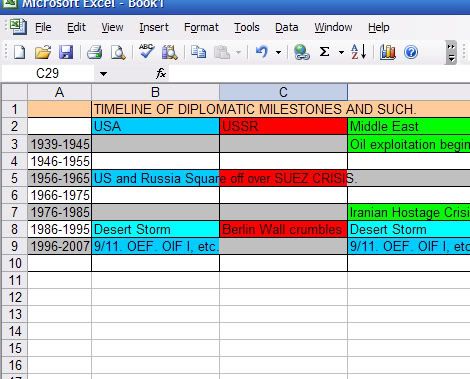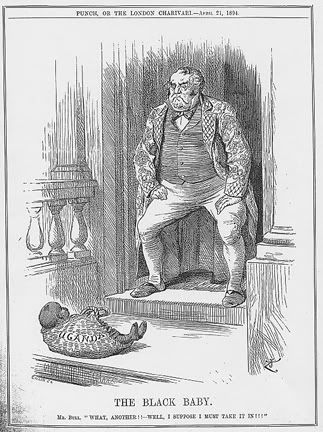Supreme Court exercise, adapted from That's Not Fair! Examining Civil Liberties With the U.S. Supreme Court.
Ohio Academic Content Standards: GR11 Benchmark A: 2 (See Objective below)
ISTE STANDARDS:III. TEACHING, LEARNING, AND THE CURRICULUM.
1. facilitate technology-enhanced experiences that address content standards and student technology standards.
3. apply technology to develop students' higher order skills and creativity.
IV. ASSESSMENT AND EVALUATION.
2. use technology resources to collect and analyze data, interpret results, and communicate findings to improve instructional practice and maximize student learning.
Subject: Social Studies
Topic: Trace Supreme Court decisions related to a provision of the Constitution.
Objective: Students will understand "patterns of historical continuity and change by challenging arguments of historical inevibility." by evaluating Supreme Court decisions and cases.
Procedure: Students organize in groups, chose a court case stemming from a challenge to a Constitutional amendment, or how “different choices would have led to different circumstances”.
- Assign students “Rights of the Accused” from the Dept. of State website. Allow them to chose from a topic heading from one of the “Rights of the People” links on the page (Ch. 3, Freedom of Speech”, etc.), or one of the hot-button issues from the ACLU website as the basis of their assignment.
- Students are to trace the evolution of a Supreme Court decision , or an issue currently in process first stating the Constitutional amendment at the core of the argument, then explaining both sides of the case, and finally examining the implications and ramifications of the conclusion (if there is one) and presenting their supposition of an alternate reality if the case had been decided in the opposite direction (or presenting both sides of a prospective conclusion).
Evaluation: Upon completion of the research, the students are then to compile individual papers on their assigned subjects and prepare a power-point presentation which they will then perform for the class in their groups.
Tools: Internet, Powerpoint.
LESSON II: Government: Campaign Finance Simulation (adapted from the “Campaign Finance Simulation” on the PBS By the People, Election 2004: For Kids, Parents and Teachers website.)
Gov’t: GR11-12: Benchmark A: Evaluate, take and defend positions about issues concerning the alignment of the characteristics of American Democracy with realities in the United States today. Benchmark A-2: Explain how individuals or groups, both governmental and non-governmental, influence domestic and foreign policy and evaluate how these actions reflect characteristics of American democracy.
ISTE STANDARDS:
III. TEACHING, LEARNING, AND THE CURRICULUM.
1. facilitate technology-enhanced experiences that address content standards and student technology standards.
3. apply technology to develop students' higher order skills and creativity.
4. manage student learning activities in a technology-enhanced environment.
IV. ASSESSMENT AND EVALUATION.
2. use technology resources to collect and analyze data, interpret results, and communicate findings to improve instructional practice and maximize student learning.
Subject: Government
Topic: Campaign Finance.
Objective: Students will gain an understanding of how special interest groups interact with the democratic process by participating in a simulation which will allow them to personally experience the mechanics of campaign finance.
Procedures:
Preparation
- For homework the students will research a PAC and a political issue of “special interest” within a certain range of choices.
- The class will vote on the issue to be used for the simulation. (A bill to be passed)
- The class will be divided into roles of real candidates and voters. Those assigned politician roles will prepare brief bios on real politicians on both sides of an issue (Politician role-players will be informed that they are not bound to their real life counterparts in how they will vote on the issue.)
- Voters will prepare brief bios on the PACS on each side of an issue. Research is internet based.
- Voters will be assigned to take one side or the other of an argument.
Simulation
Round I
Politicians and PAC members will be split up into opposing forces (for and against a certain issue).
- Teacher restates the issue to be voted on.
- Voters are tasked with voting to get the bill passed for their assigned “side”.
- Voters are issued a “voting record” template (will vote in favor of, probably will, maybe, maybe not, definitely not). Voting records will be kept on Excel spreadsheets. Each Voter is responsible for maintaining their own individual record through all phases of the exercise.
- Voters are organized into groups of mixed positions, and are given 5 minutes each with the candidate to try and convince him to vote their way.
- Voting records will be scored and averaged so students will see how they might judge whether a candidate might or might not vote on a certain issue.
Round II
1. Candidates are informed that the acceptance of a donation implies they will vote a certain way. The total amounts of donations in specific camps will determine how they vote on the issue.
2. Voters are issued $2000 (in $100 denominations) in “Monopoly” money each.
- Voters are told they can only give $1000 maximum to each political candidate.
- Voters and Candidates meet again. Candidates are instructed that they are trying to raise as much money for their campaign as possible.
- Candidates are again assessed for how they will vote on a particular issue as promised when they receive money from Voters.
- All students assess the voting records to see if the introduction of money changed any of the voting records.
- Candidates will record how much money they acquired through donations on Excel.
Round III
- Voters can now form groups up to 3 to canvass Candidates for support of their issues and donate money. Same $1000 limit/voter applies. Some voters should be instructed to act individually. Voting records are kept again.
- Voting records are then assessed to see if groups of students had any more influence the candidates than when they were in individual groups.
- A winner will be declared
- Candidates who had the best voting record will explain their strategies for accruing the most money.
Evaluation: Students will then briefly examine the dynamics of the process in a paper, relate their experiences and include a segment on how a real PAC influenced a certain issue (
through using internet research.)
Tools: Internet, Excel, "Monopoly" money.


